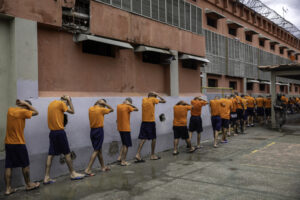Human Rights in Mexico: Excerpts from the Country Reports on Human Rights Practices 2003. Released by the U.S. Department of State, Bureau of Democracy, Human Rights and Labor, on February 25, 2004
The Government appeared to stall in its attempt to improve the domestic human rights situation, with a few exceptions.
On December 8, the Office of the U.N. High Commissioner for Human Rights presented the President with an analysis of the human rights situation in the country. President Fox commissioned the study in 2000, and upon its receipt promised to implement its 32 recommendations that included overhauling the judicial system in favor of one based on oral arguments; rejecting confessions obtained by torture as evidence in criminal trials; creating of a system of juvenile justice laws; changing the military justice system in which soldiers accused of human rights violations are tried in secret and the outcomes of their trials are rarely made public; and implementing new mechanisms to curb violence against women and discrimination against indigenous people.
Torture
The police sometimes tortured persons to obtain information. Prosecutors used this evidence in courts, and the courts continued to admit as evidence confessions extracted under torture. There were cases of police torture of suspects in custody that resulted in deaths.
The Constitution and the law prohibit torture; however, it continued to be a serious problem. The Constitution excludes as evidence confessions obtained in the absence of the accused person's defense attorney, and the law excludes coerced confessions, including those extracted under torture. However, the police regularly obtain information through torture, prosecutors use this evidence in courts, and the courts continue to admit as evidence confessions extracted under torture. The military also has been accused of using torture.
The authorities rarely punish officials for torture, which continues to occur in large part because confessions are the primary evidence in many criminal convictions. Many human rights groups linked torture to the prevalence of arbitrary detention and claimed that torture often follows an arbitrary arrest, sometimes without a warrant, as police or prosecutors attempt to justify the detention by securing a confession to a crime. Poorly trained and inadequately equipped to investigate crimes, police officers often attempted to solve crimes by rounding up likely suspects and extracting confessions from them by force.
A particularly serious abuse of due process is the prosecution's ability to base its case on evidence gathered by means of torture. While torture itself is a criminal act, judges allow statements coerced through torture to be used as evidence against the accused and confessions were the primary evidence in many criminal convictions.
Members of the federal and state police, as well as military personnel, were accused of committing killings during the year.
Judicial System
Arbitrary arrest and detention continued to be among the most common human rights abuses.
Police corruption is a problem. Police have been involved in kidnappings, armed robbery, and extortion, as well as protection of criminals and drug traffickers.
Based on the Napoleonic Code, the trial system consists of a series of fact-gathering hearings at which the court receives documentary evidence or testimony. However, in 2001 Amnesty International alleged that judges often were not present at hearings when defendants give testimony. Court officials may add notarized documents that are not authenticated into the case file. A judge in chambers reviews the case file and then issues a final, written ruling.
In the case of indigenous defendants, many of whom do not speak Spanish, the situation is often complicated. The law calls for translation services to be available at all stages of the criminal process; however, the courts do not routinely provide translators for indigenous defendants at all stages of criminal proceedings, and thus defendants may be unaware of the status of their cases… [and may be] convicted without fully understanding the documents they have been required to sign.
Chiapas
The peace process [in Chiapas] remained stalled at year's end. The break in contacts between the Government and the EZLN, that occurred when Zapatistas rejected the Law on Indigenous Culture and Rights passed in 2001 as a watered-down version of the San Andres Accords, continued during the year. In August, the Government called for a resumption of the dialogue. Conditions such as poverty and inequality that gave rise to the armed conflict in 1994 persisted. Sporadic outbursts of politically motivated violence continued to occur throughout the country, particularly in the southern states of Chiapas, Guerrero, and Oaxaca.
In May, the [National Human Rights Commission] stated that it would present to the Federal Government evidence of irregularities in the investigation into the 1997 killing of 45 persons in Acteal, Chiapas. These irregularities included the obtaining of statements in Spanish from accused individuals who did not speak the language and were never provided translators, and shell casings collected at the scene that did not match weapons confiscated and supposedly used in the killings.
In the most detailed report on displaced persons, the Fray Bartolome de las Casas Human Rights Center (FRAYBA) released a 245-page report in 2002 that documented the displacement since 1995 of more than 12,000 persons from 2,400 families in Chiapas. The report accused the Government of being responsible for the displacements and not keeping its constitutional commitment to provide for the security of its citizens as well as its obligation to provide humanitarian assistance to internally displaced persons (IDPs) under international law….
Murders of Women in Ciudad Juarez and Chihuahua
The most pervasive violations of women's rights involve domestic and sexual violence. Both are widespread and vastly underreported.
In November 2001, the bodies of eight young women who had been raped and murdered were found in an empty lot adjacent to a busy intersection in Ciudad Juarez. State authorities arrested two bus drivers accused of the crimes within 3 days but the drivers allege their confessions were obtained under torture. Their attorney was subsequently shot and killed by the State Police following a high-speed car chase during which the attorney called his father and reported that he was being pursued. The police originally alleged that he had died of injuries received when his car crashed but were forced to retract that information when it was revealed that he had been shot in the head. The officers involved in the case were questioned but never charged nor disciplined. An internal investigation cleared them of any wrongdoing. The bus drivers were jailed pending sentencing. One of them died in prison during the year under suspicious circumstances after a surgical intervention. …. Authorities initially said he had died after complications from a recent hernia operation, but later stated that he had died of a heart attack.
The State Attorney General’s office claimed that following DNA identification, it had identified positively six of the eight murdered women [discovered in November 2001], whose bodies the families had buried; however, subsequent information revealed that the identifications were mistaken. When the families demanded additional DNA tests, the State Police claimed the DNA evidence was lost.
In February, the remains of three young women were found in the outskirts of Ciudad Juarez.
On March 16, 16-year-old Viviana Rayas disappeared from her parent's home in Chihuahua City. On May 29, the Chihuahua daily El Heraldo quoted a Chihuahua state police sp
okesman who stated that human remains found on the outskirts of town were those of a 35-to 40-year-old woman. Frustrated at the Chihuahua State Police’s inability to solve his daughter’s disappearance, on May 30, Viviana’s father and powerful union leader Jose Cirilo Rayas threatened to paralyze Chihuahua state construction projects if his daughter was not found soon. Days later, the police changed their story and enlisted a government dentist to claim that the remains were those of 16-year-old Viviana’s. Within days, the police arrested foreign resident Cynthia Kiecker, her husband Ulises Perzabal, and three friends of the couple, who all alleged that they were tortured physically and psychologically to extract false testimony regarding the murder of the young girl. Kiecker alleged that the police put a bag over her head, showered her with water, and tortured her repeatedly with electric shocks. She said she was forced to participate in a videotaped confession to the murder. All five later recanted their statements. As of September, hearings in this case continued in the First Penal State court in Chihuahua City, and Kiecker remained in prison. The Chihuahua state government had taken no substantive action to address allegations of torture by its police officers.
In July, federal authorities launched the United Security Program which brought 300 Federal Preventive Police (PFP) to the city. The program put the PFP in charge of public safety in Juarez, with authority over the municipal police. The number of PFP in Juarez rose to 770 in late September. Although the program is intended to curb crime in general, it includes among its tenets the protection of, and public education on, women’s rights.
In August, AI reported that during the previous 10 years, approximately 370 women had been killed in the Ciudad Juarez and Chihuahua areas, with 137 of them involving sexual violence. A number of the missing or killed women were employed in "maquiladoras," or assembly plants. Many were young, in their early teens or twenties, and had been strangled. Their bodies were then dumped in the desert. The report was highly critical of the methods of state authorities in investigating the cases.
In August, the Chihuahua Women’s Institute (ICHIMU) calculated that 321 women were murdered in Ciudad Juarez since 1993, including 90 that were sex-related homicides, possibly the work of a serial murderer or murderers.
On October 17, President Fox named Guadalupe Morfin Otero as the head of the new federal Commission to Prevent and Punish Violence Against Women in Ciudad Juarez. Morfin described her duties as crime prevention and victims’ assistance.
On November 24, the [National Human Rights Commission] CNDH published a report on the killings and disappearances of women in Ciudad Juarez that was highly critical of the investigations. The report severely criticized negligence on the part of local and state law enforcement that it characterized as a disregard for the human rights of victims and their relatives. The report described the situation in Ciudad Juarez as a public safety and law enforcement crisis.


